ISSN ONLINE(2320-9801) PRINT (2320-9798)
ISSN ONLINE(2320-9801) PRINT (2320-9798)
| Anjali M. Patil, Prof.R.M.Goudar Department of Computer Engineering, MIT Academy of Engineering, Alandi (D), Pune, India |
| Related article at Pubmed, Scholar Google |
Visit for more related articles at International Journal of Innovative Research in Computer and Communication Engineering
Telemedicine systems plays an important role in healthcare services. Nowadays, mobile phones are widely used by most people. As the rapid growth of the mobile phone, it is possible to apply the mobile phone to be a part of telemedicine system. Healthcare data is very sensitive and hence , it must be protected against unauthorized access. The proposed system provides both reliable protection and access to data by authorized medical staff. In this paper, a scheme has been proposed which uses compression Here, while transmission of data, first its is compressed to reduce data size and to increase data transfer rate The proposed system illustrates an attempt to replace paper-based work plan with an electronic version.
Keywords |
| Biomedical data , Data compression , Dictionary , Huffman algorithm , Mobile health management |
INTRODUCTION |
| The Internet and mobile networks have penetrated the healthcare sector due to their low cost, increased functionality, easy to use nature and high reliability. Telemedicine is the use of telecommunication and information technologies to provide health services at a distance. Telemedicine system is divided into two fields: one is that mobile devices are used by patient himself to measure medical data and can read the medical data.e.g. Perk flow monitoring system[1]. The other field is that the mobile devices are used by the medical staff for their daily work. In India, paramedical system has been developed using mobile phones to get medical information about mother and child health[2]. |
| Mobile devices cannot carry physically doctors, drugs and equipments between the location but can carry and process information. With the increasing globalization, it is useful for individuals to move around the world. So, it is important that medical records of individuals can be globalized for enhancing the healthcare delivery while individuals are on the move. Removable media like memory card has paved the way for an individual to carry personal information. Being robust and portable, memory card represent a technology that can be employed in health care to provide distributed storage of patient’s medical records[3]. This medical information may be useful , when the patient has to visit another physician, than usual . Therefore, to have information access anywhere and anytime the proposed system stores data in mobile device. |
II. RELATED WORK |
| In [4] author defined method where Block sorting converts the original blocks of data into a format that is extremely well suited for compression. Star transform is to define a unique signature for each word replacing the letters of the word by a special character(*) and to use minimum number characters in order to identify precisely the specified word. The objective of proposed system[5] is to establish low complexity loss less compression scheme suitable for smart devices like cellular phone . System uses character masking with space integration , syllable based dictionary matching and state hiding in hierarchical steps to achieve low complexity loss less compression of short text. |
| With the rapid growing of data and number of applications, there is a crucial need of dictionary based reversible transformation techniques to increase the efficiency of the compression algorithms and hence contribute towards the enhancement in compression ratio. Performance analysis of compression methods in combination with the various transformation techniques is obtained for different text files of varying size by author[6]. The popular block sorting lossless Burrows Wheeler Compression Algorithm (BWCA) is implemented along with one proposed method. For efficient compression a dictionary based transformation algorithm is also developed. It is observed that much increase in terms of compression ratio is attained when a source file is pre-processed with dictionary and then applied to BWCA and the proposed method. In [7] authors described efficient dictionary based compression techniques for data compression. The main goal is to design dictionary which provides high compression ratio. Here main idea is to replace English words by short words in designed dictionary. |
III. SYSTEM ARCHITECTURE |
| The proposed system is mainly composed of there parts: Patient’s mobile phone , Remote information server and Physician’s mobile phone. Patient’s health related data is stored in mobile device. Authorized user is allowed to access the stored information. Overview of the system is as shown in Fig.1. |
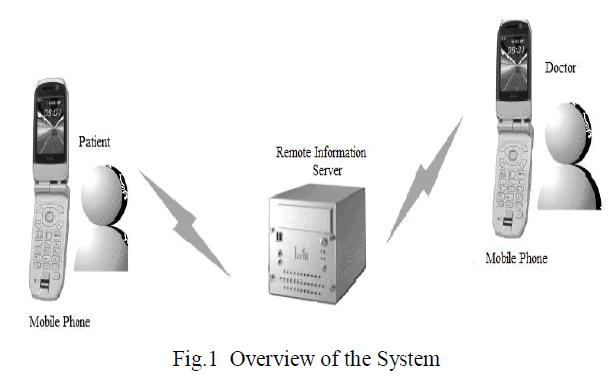 |
A. Patient’s Mobile Phone: |
| Java application on mobile phone implements following functions : reading history of patient, edit profile information and current prescription given by the physician whenever required. Functions are shown in Fig.2 |
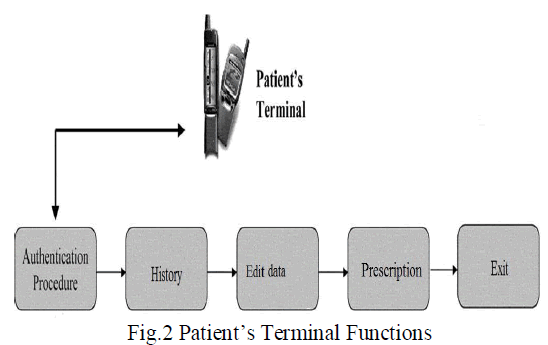 |
B. Remote Information Server: |
| Remote information server is web server, Apache tomcat server. The server can be accessed both from the patient’s mobile phone and physician’s mobile phone. Remote information server in the hospital stores information about the patient like patients name , data of visit, diseases and medicines prescribed by the physician. Server admin create dictionary and store it. This dictionary contains code words for particular characters. This dictionary helps to compress data. |
C. Physician’s Mobile Phone : |
| The proposed system still facilitates the communication with the patient, if the doctor is outside the hospital or is on the tour. Java application on mobile phone allows doctor to view patient list and to give prescription to the required patient and this updated prescription is read by the patient on his/her mobile phone, hence reduce the cost and time for communication. Fig.3 depicts a block diagram with a menu of the functions that a physician can accomplish. |
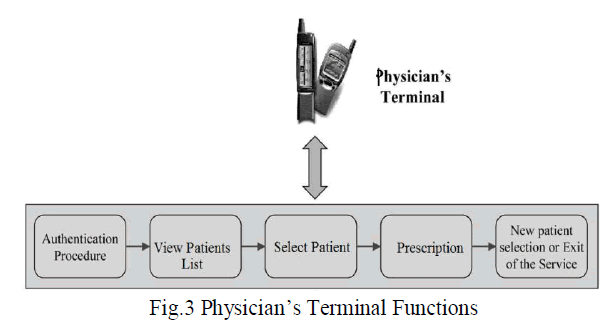 |
IV. PROPOSED ALGORITHM |
| Compression is the science of representing the data in a reduced form rather than its original form[8].Using data compression, the size of original file can be minimized. Speed is primary goal when data compression is used in data transmission application. Speed of transmission is calculated by number of bits sent and time required for encoder to generate codeword and time required to recover the original data by the decoder. Degree of compression is the important factor in a data storage application.Fig.4 shows diagrammatic representation of compression. |
 |
| Proposed system used Dictionary technique for compression. Dictionary is used to store codeword for each character. Methodology used in proposed technique: |
| A. Data pre-processing |
| B. Compression |
| C. Decompression |
| A. Data pre-processing: |
| Input for the system used are patient name, diseases, prescription given by doctor etc are considered and Huffman algorithm is used to produce the intermediate processed data and processing steps are as follows. |
| 1. Open text data |
| 2. Collect character count from file |
| 3. Sort entries by count |
| 4. Form priority queue |
| 5. Iteratively build list from this priority queue |
| 6. Codeword created for each character is stored in a file |
| Flowchart for Dictionary creation is as shown in Fig 5. |
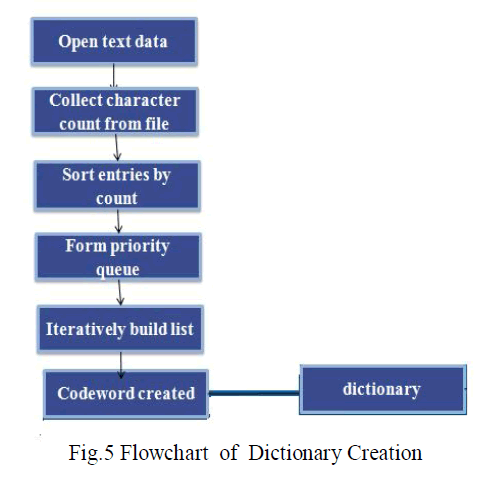 |
B. Compression: |
| In proposed compression algorithm, first text is converted into binary sequence using dictionary then this binary sequence is then divided into number of blocks. Each block is of size 12 bits. Now, for each block its decimal value is calculated. Afterwards, frequency of occurrence of each block is calculated. These blocks are sorted according to frequencies.Finally,each block is converted into bits according to it’s sequence number. |
C. Decompression: |
| In decompression process, dictionary and encoded text are used where first compressed file is opened and bits are read. After reading, bits it will find its equivalent decimal number. Now, this decimal value used as sequence number and converted into bit block. This bit block finally converted into character and original data is recovered. The advantages of proposed algorithm over Huffman algorithm are described as below. |
| In Huffman algorithm, first it will count frequency of each character; it will sort them to form priority queue and take two nodes with less weight until it will get single root[9,10].So, whenever file is to be compressed it goes through all steps that are required to create tree and finally have codeword for each character, but, in proposed technique there is no need to do all steps for creating codeword for each character because codeword are created in prior, thereby compression time is saved and also memory space is saved as there is no need to send tree every time over the network. In case of Huffman algorithm, it has to create tree every time and also has to send tree over the network so it will consume more memory space and time for compression. |
V. EXPERIMENTAL RESULTS |
| In this section , main focus is to compare the performance of proposed dictionary based compression algorithm with the existing compression algorithms. Research work is done to calculate the efficiency of proposed algorithm considering three important parameters i.e compression time , compression ratio and saving percentage for space .Different file size are tested for the different techniques and have found out the results. Table.I shows comparison between the compression ratio obtained for Burrows Wheeler Transform(BWT) , Intelligent Dictionary based Encoding(IDBE) and proposed dictionary based algorithm. |
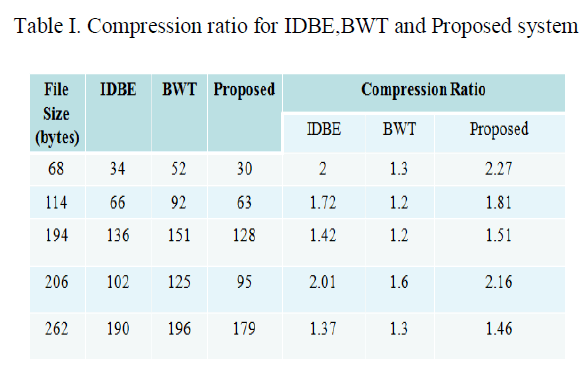 |
| Fig .6 shows the compression ratio of IDBE,BWT and Proposed algorithm |
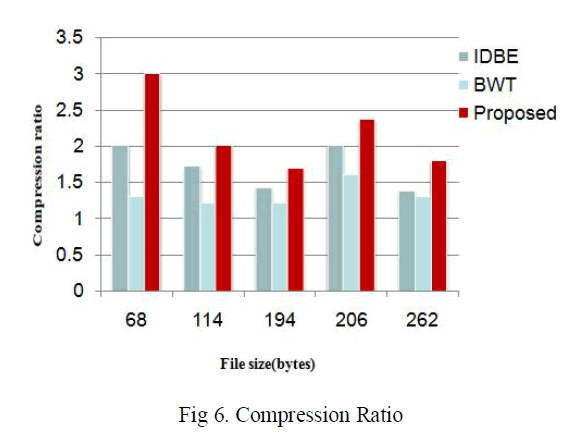 |
| Result shows that compression ratio for proposed technique is more than BWT and IDBE compression algorithms. |
| Table.II shows comparison between the compression time obtained for BWT, IDBE and Proposed algorithm. |
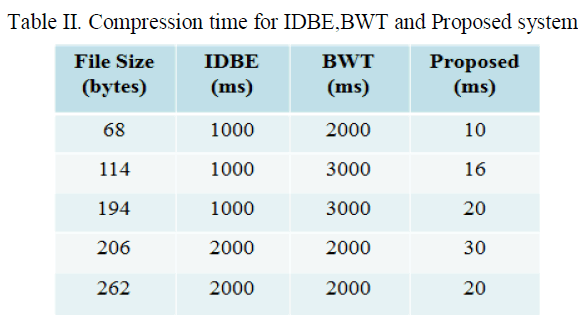 |
| Fig.7 shows the compression time of selected files for all the algorithms. |
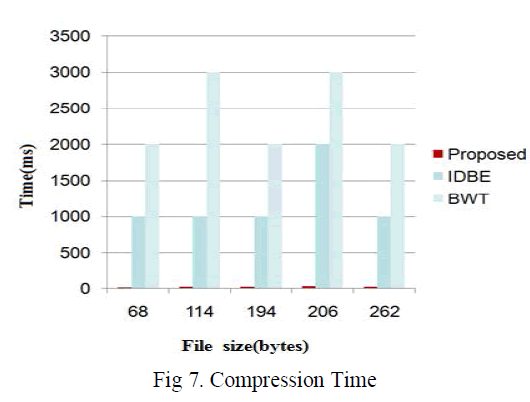 |
| Result shows that compression time of proposed technique is less than other lossless compression algorithms. . |
| Table III shows comparison between the saving % memory space for file size obtained for BWT ,IDBE and proposed dictionary based algorithm |
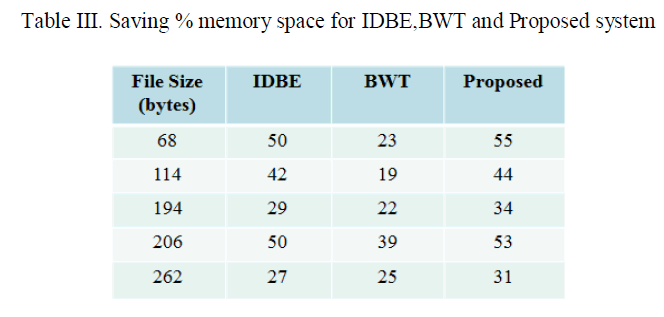 |
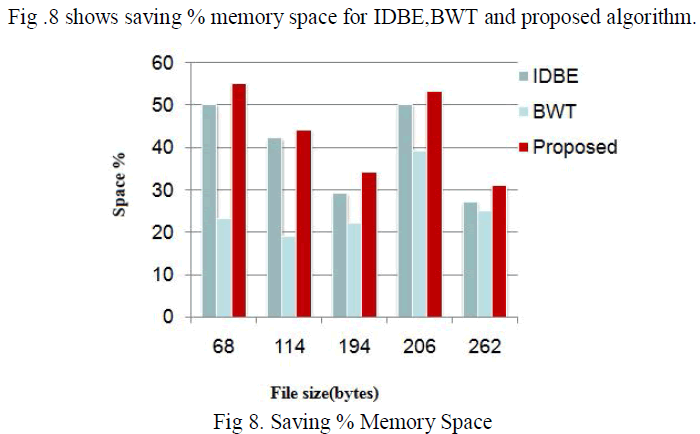 |
| Result shows that memory space saved for proposed technique is more as compared to IDBE and BWT. |
VI. CONCLUSION AND FUTURE WORK |
| The proposed system provides an excellent method of data compression to increase the message transfer rate and reduction in space requirement for data storage. System provides continual health care delivery even while an individual is on the move and also replaces the existing paper based work by e-version.In the future work, system can be developed where mobile device is selected as a portable platform to receive the reported information. This reported information includes CT-Scan , MRI images to protect their high resolution quality while saving on bandwidth. |
References |
|